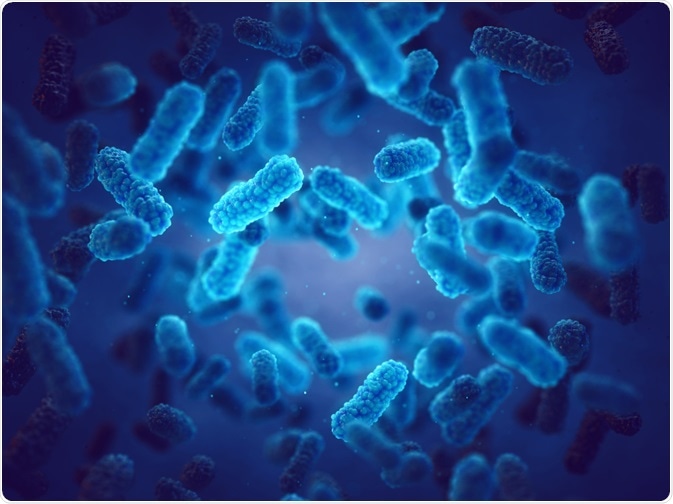What is Bacterial Pathogenesis?
The processes which lead to disease are complex and have many contributing factors both internal and external. This article will provide an overview of bacterial pathogenesis and its contributions to the development of disease within a host organism.

Image Credit: nobeastsofierce/Shutterstock.com
Pathogenicity – An overview.
A pathogen is a term that refers to a microorganism that causes disease in an organism. Pathogenicity is the ability of the pathogen to produce disease. Pathogenicity is expressed by microbes using their virulence, or the degree of the microbe’s pathogenicity.
Genetic, biochemical, and structural features that lead to the ability of the pathogen to cause disease are known as its determinants of virulence. Genetic and molecular factors play a large part in a microorganism’s pathogenicity.
The relationship between host and pathogen is dynamic – each modifies the function and activities of the other. The relationship and, therefore, the degree to which disease progresses in the host organism is determined by the pathogen’s resistance and the resistance and susceptibility of the host organism, largely in part due to the effectiveness of the host’s defense mechanisms.
Bacteria can largely be organized into three groups. Frank or primary pathogens are considered to be probable agents of disease. Opportunistic pathogens become pathogenic following the perturbation of a host’s defense mechanisms (for example by wounds, aging, and disease.) Finally, there are nonpathogens, such as Lactobacillus acidophilus, which are present naturally within the host and rarely or never cause disease.
Factors in Bacterial Pathogenicity
As mentioned, disease progression within a host organism is a complex and dynamic process. There is a multitude of factors both about the pathogen and the host which affect bacterial pathogenicity and thus cause any number of different outcomes for a previously healthy organism.
Bacterial Infectivity
It is in the best interests of the pathogen not to kill the host as its objective is to multiply. However, if there is an imbalance between host resistance and bacterial virulence, this may lead to increased pathogenicity and potentially fatal outcomes.
Host Susceptibility
A healthy, intact immune system, including phagocytic cells, is vital for the best possible defense against pathogenic infections. Initially, resistance is conferred by non-specific mechanisms, with specific immunity developing over time. Any number of factors can lead to a compromised immune system and therefore increased host susceptibility.
Factors that can affect host susceptibility include conditions such as HIV which cause immunosuppression, aging (older people are more susceptible to disease than younger patients) medication and treatment for conditions such as cancer, and in some cases diet and nutrition and the health of the host’s microbiome.
Host Resistance
Host resistance plays a large part in the severity of infection progression. Numerous attributes of the host come into play when the host is exposed to pathogens, both chemical and physical. These include mucosal surface secretions with several antibacterial factors and phagocytic cells which mediate inflammatory responses through complex signaling pathways.
Many lymphoid cells participate in this inflammatory response. To be able to effectively infect an organism, pathogenic microorganisms must be able to overcome these defense mechanisms and host attributes.
Bacterial Virulence Factors
Virulence factors aid in the bacteria’s ability to invade, cause disease, and evade host defense mechanisms. Some are listed below.
Adherence Factors: The ability to physically attach to mucosal sites can increase bacteria’s pathogenicity. Many pathogenic bacteria use pili to adhere to host cells.
Capsules: Protective capsules exist on many pathogenic bacteria, which helps to protect them against host defense mechanisms including phagocytosis.
Endotoxins and exotoxins: Lipopolysaccharide endotoxins can cause fever, blood pressure changes, and lethal shock. Exotoxins are secreted by pathogenic bacteria and include neurotoxins and cytotoxins.
Siderophores: Some pathogenic bacteria can use siderophores to compete with the host for iron, which is an essential growth factor.
Intracellular Growth
Most pathogenic bacteria multiply in tissue fluids rather than host cells, but some species (for example Rickettsia) can only multiply and proliferate within eukaryotic cells. Salmonella bacteria invade cells but do not require them for growth.
Host-mediated Pathogenesis
Sometimes, tissue damage can result from the host’s own immune system when responding to invasion and bacterial toxins. This is the case with diseases such as tuberculosis.
Bacterial Pathogenesis and Antibiotic Resistance: A Growing Problem
Across the span of human history, pathogenic bacteria have been one of the main killers of human and animal populations, causing untold misery to human civilization. Throughout the 20th Century, medical science managed to make significant progress against pathogenic bacteria and the diseases they cause through the use of antibiotics.
However, due to antibiotics being over-prescribed by medical professionals and the over-use of antibiotics within the dairy and meat industries, there are several worrying setbacks in the fight against bacterial infection. New drug-resistant strains of bacteria including MRSA have emerged over the past few decades, and ‘old’ diseases such as tuberculosis have now adapted and are on the rise in developing countries where previously they were close to eradication.
Currently, medical professionals are researching several alternatives to antibiotics to increase the effectiveness of medical science in combating infection.
In Conclusion
The relationship between host and pathogen is a complex one that is constantly evolving. Pathogenicity depends on a variety of factors both belonging to the microorganism and the host and any perturbations in this relationship can have profound effects on the progression and severity of the disease caused.
Whilst modern medicine has largely managed to effectively treat a bacterial infection, growing issues such as antibiotic resistance show that there is clearly some way to go before we can completely eradicate disease.
Sources
- Peterson, J.W. (1996) Bacterial Pathogenesis Medical Microbiology 4th edition. [Accessed 01/09/2020] https://www.ncbi.nlm.nih.gov/books/NBK8526/
- Brown, S.P, Cornforth, D.M & Mideo, N. (2012) Evolution of virulence in opportunistic pathogens: generalism, plasticity, and control Trends Microbiol. 20(7) Pp. 336-342 [Accessed 01/09/2020] https://www.ncbi.nlm.nih.gov/pmc/articles/PMC3491314/
- WHO Fact Sheet: Antibiotic resistance (2020, Online) [Accessed 01/09/2020] https://www.who.int/news-room/fact-sheets/detail/antibiotic-resistance
Last Updated: Dec 2, 2020

Written by
Reginald Davey
Reg Davey is a freelance copywriter and editor based in Nottingham in the United Kingdom. Writing for News Medical represents the coming together of various interests and fields he has been interested and involved in over the years, including Microbiology, Biomedical Sciences, and Environmental Science.
Source: Read Full Article


